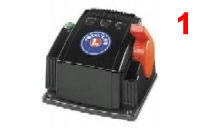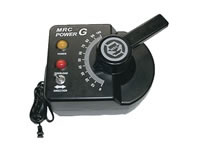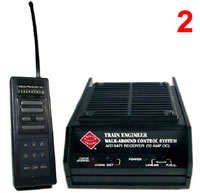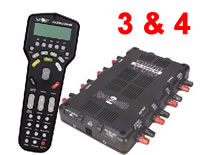The Control Systems
All of the model trains at the Grand Central Railroad Park actually run by electricity.
The electricity to run the trains come from one of two sources:
-
A step-down transformer which takes regular house current and lowers it to the levels required by the model trains (0 - 24 Volts). In addition, most of the trains run on direct current (DC) like the current from a battery. The step-down transformer includes rectifiers or more complicated electronics to ensure the trains get the electric power they need.
-
An actual (rechargeable) battery is carried right on board the train and the electricity is supplied by wires to the engine (not from the track). This on-board battery can be hidden inside the locomotive tender, a "B" unit diesel or even in a box car right behind the engine.
Controlling the electric power to each engine is an important aspect of model train operation. Each train needs to be set to go in either a forward or reverse direction. The train speed needs to be carefully controlled to simulate real train operations. There is a "high ball" speed which may be set based upon the capabilities of the engine, and the condition of the track (both how good the track is as well as how tight the curves are). Slower speeds are required when entering cities/towns, when approaching a yard or passenger station, or when coupling up cars.
Train Control: Control of each individual train is accomplished in any of five different ways.
- First, by manual control of a lever on a step-down transformer much like an early Lionel train, which varies the power to the track/trains. This requires the operator to be physically at the transformer to control the train. The direction of the train is also controlled here.
(examples 1 on left) - Second, a radio receiver/controller is connected between the step-down transformer (above) and the track. The associated radio control handset enables the operator to vary the voltage levels put on the track for the train with radio signals. In most cases, this remote control also enables the operator to control the engine to go forward or backwards, to sound the steam whistle or diesel horn, and other functions. The operator can be anywhere on/around the layout and still maintain control of the train.
(example 2 on left) - Third and Fourth, the power on the tracks is set at a constant level and control of the train is EITHER by radio signals OR by digital signals (like "instant messages") OR both to the receiver/controller in the engines. These methods require a remote handset for the operator to send the radio or digital signals to the trains. Either method allows the operator freedom to move anywhere on the layout and maintain control of the train. An additional benefit of radio or digital control is that each individual engine may be assigned an address (think of this as a name) so that one remote control may "talk to" different engines individually or as groups (lash-ups).
(example 3 & 4 on left) - Fifth, the power can be from batteries actually carried on the train itself. This usually includes either a radio or digital control handset to vary the power from the batteries to the engine. This control method does not require power from the tracks or signals from the tracks. The battery powered train can often run with other trains, battery powered or track powered, on the same section of track.
Why five methods? Each method above provides specific advantages to the operator and each member chooses what is best for their needs. At the GCRR we often have each of these control methods being used at the same time... and when done right, most people can't see the difference.
Where to start? The easy way to start is to use a model train transformer, connected directly to the track with two wires and you have full control of your train... start/stop, forward/reverse, and speed.
The GCRR Members will be happy to answer any questions you may have about how their trains are controlled or how you can get started with your own model trains.
Talk with anyone for assistance.



